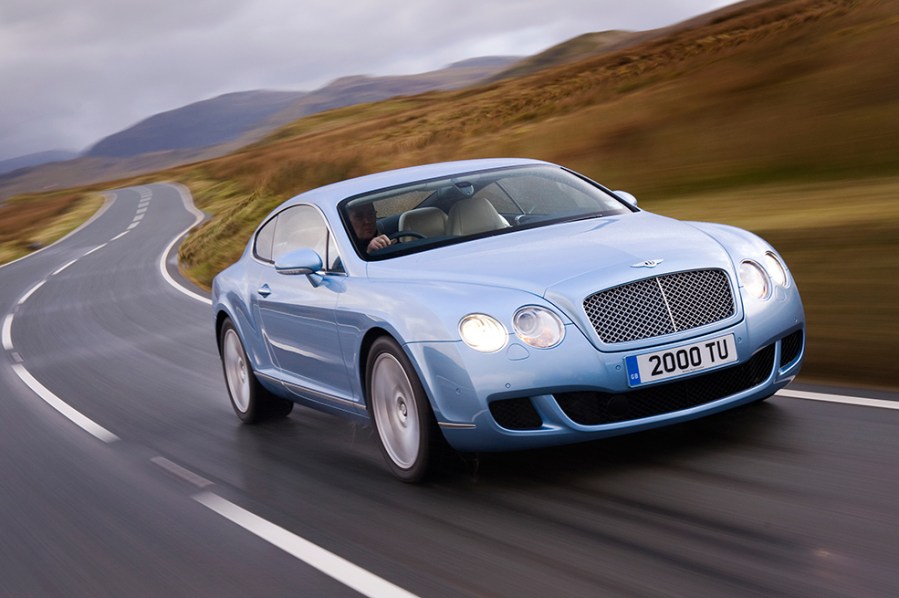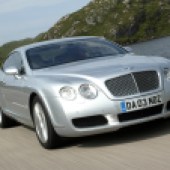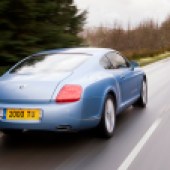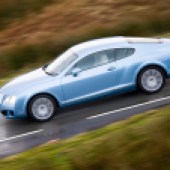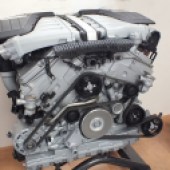The upmarket Volkswagen which emerged from the struggle between two German makers for control of an iconic British brand.
I was stuck in traffic earlier this month and idly studying the cars surrounding me, I realised that what at first glance looked like an up-spec Passat in the next lane was actually a VW Phaeton.
Anyone who knows their cars will be aware of the Phaeton, VW Group chief Ferdinand Piëch’s magnificent folly supposedly commissioned purely to give Mercedes a bloody nose for daring to impinge upon the Golf segment with its A-class.
As history proved, despite its trick dashboard vents and a generally dense level of technology from stem to stern, the Phaeton really didn’t make the slightest dent in S-Class sales. What it did do, however, was serve as a very low-key testbed for what would be the first all-new Bentley model since 1931.
Bentley had ended up in VW Group ownership in 1997 when at the last minute the Wolfsburg maker had outbid BMW for the Rolls-Royce and Bentley car-building business. Both parties wanted the Rolls-Royce brand and Bentley was very much a secondary bonus, but after the deal was done it transpired that while VW had acquired the car designs, production facilities, the radiator shape and Spirit of Ecstasy mascot, the Rolls-Royce name remained in the ownership of Rolls-Royce Plc the aero-engine maker.
BMW was also supplying engines for Rolls-Royce and Bentley models under a supply contract which allowed it to terminate the agreement with just 12 months’ notice – not enough time either to re-engineer the cars to borrow a big Audi V8 or to develop a new powerplant from scratch.
All this weighted things in BMW’s favour, the end result being that the company coughed up the £40m to licence the Rolls-Royce name from Rolls-Royce Plc and a deal was done under which VW made both Rolls and Bentley cars with BMW-supplied engines from 1998 until January 1, 2003 after which the marques would be split: BMW would produce its own all-new Rolls-Royce in a new Goodwood factory and VW would produce a new line of Bentley branded cars in the historic Crewe location.
In order to avoid losing face, Volkswagen’s PR machine span the story into a success, the company line being that it wanted the higher-volume Bentley brand all along.
With just three years to come up with a brand new model, both parties had their work cut out and both borrowed heavily from their existing line-up. Just as BMW based its Phantom extensively on the then-current 7-Series, VW used significant amounts of technology developed for the Phaeton in its new Bentley. Indeed, the Continental GT is based on the same ‘D1’ platform as the Phaeton and Audi A8.
Perhaps the biggest element of this was the remarkable powerplant, which is unique in the world in being a ‘W12’ configuration. Initially it can be hard to get your head around the idea of this engine until you look more closely at its layout and realise that it’s effectively two of VW’s narrow angle ‘VR6’ engines sandwiched together. The resulting engine uses four banks of three cylinders, although both outer pairs of the four banks are at just 15 degrees so that it looks at first sight like a conventional vee engine. This configuration does mean that its length is surprisingly short at 635mm, which in turn makes it easy to package despite its power.
The W12 idea was first showcased in the Nardò W12 concept which previewed the mighty Bugatti Veyron but its first production appearance was in the Audi A8 in 2001, before it appeared in the unassuming Phaeton in 2002.
In the A8 and Phaeton, the engine produced 414 bhp but more was needed to provide the crushing performance required of the Bentley – which needed after all to eclipse the pace given to the old Turbo R models by the venerable Rolls V8.
This was done by bolting up a pair of KKK blowers to the W12, which required much modification to the block and internals. The pistons were modified to provide a compression ratio of 9:1, while the engine also features seven main bearings and variable valve timing on each of the four cams and 48 valves.
VW also boasted that much work had gone into allowing the turbocharged engine to use air-to-air intercoolers rather than air-to-water chargecooler units.
The KKK turbos were spun up at a conservative 0.7bar of boost but despite that, the headline result was a hefty 552 bhp at 6100 rpm and 479 lbf.ft torque from just 1600rpm.
It was this torque which gave the new Bentley the relentless urge required to match its heritage and it also required a new gearbox to handle it. Clearly buyers at this end of the market weren’t likely to sully themselves with the onerous task of working clutches and levers but rather than try to engineer a self-shifting manual box which could work smoothly enough yet also avoid melting under the strain, Bentley approached automatic specialists ZF.
A six-speed automatic was duly developed which could handle the torque but which also had the facility to lock up the torque converter in each of its six ratios for immediate response and improved economy. As had become the norm by then, the driver had a manual shift option via the selector lever or steering wheel paddles.
The ZF 6HP26 was in fact supplied to other makers but what distinguished the Bentley version was that it had been adapted to work with four-wheel drive, the system using a torque-sensing (Torsen) centre differential and open diffs in each axle. Bentley’s reasoning was that the car has no pretensions at all to off-road ability and so with the electronic stability control able to brake a spinning wheel individually, drive can still be directed to the corner with the most grip. In regular driving the drive is split equally between the axles, an arrangement which Bentley reckoned struck the ideal balance between safety and handling poise.
All this technology was wrapped up in a body which was claimed as being styled in-house in Bentley’s Crewe studios but which was the work of Dirk van Braeckel, a Belgian designer who had begun his VW Group career at Audi before heading up Skoda design before moving to Cheshire. His brief was to recapture the Bentley heritage without producing something self-consciously retro and he duly delivered: with its short front overhang and muscled haunches, the Continental GT has overtones of the ’50s Mulliner R-Type Continental but with a thoroughly modern clean look.
The structure of the bodyshell itself was impressive, too. One of Piëch’s goals with the Phaeton had been class-leading torsional rigidity and the Bentley followed suit. Making a car this size – especially one with pillarless side glass – rigid without being massively heavy is a big ask, but using technology including adhesive bonding and laser welding, VW and Bentley were able to keep kerb weight down to 2350kg. It’s a hefty beast, but not as hefty as it could be considering that it can seat four six-foot adults in comfort, yet achieve 198 mph and sprint to 60 mph in an impressive 4.7 seconds.
Underneath was found wishbones at each corner with anti-roll bars and an electronically controlled air suspension which allowed the car to squat by 15 mm at 100 mph. On the inside, the GT was a neat mixture of new world and old, with the high-tech elements neatly offset by subtle use of leather and hand finishing.
The Continental GT was announced to the press on March 3, 2003 at the Geneva motor show and by March 24, a staggering 3200 deposits had been taken for the new car. The enthusiasm was no doubt fuelled by the price, which at £110,000 was almost half that of the older, hand-built Bentleys. It suggested the truth of VW’s market research which had identified a niche for a car offering the performance levels of a supercar but without the compromises. Almost half of these customers were new to the Bentley brand and far younger than the traditional buyer: Bentley let on at the time that most were in their 40s, with net worth in the rather curious phrase ‘singular millions’.
Rather closer to earth, the rebirth of the Bentley company spearheaded by the Continental GT meant 400 additional staff had joined the firm by the time of the car’s launch, with the Crewe workforce eventually growing from just 1500 in the late ’90s to a current level of around 4000.
The technology under the Continental GT would subsequently be expanded to the four-door Flying Spur, plus the convertible Continental GTC. In 2008 the 602 bhp Continental GT Speed was added to the range, alongside the Mulliner Driving Specification option which shed 35 kg and was effectively a sports package. Other than that, the GT continued largely unaltered until it was replaced by the second-generation car in 2011, which retained the W12 engine but added a V8 option from 2013.
As a modern classic meanwhile, the first-generation Continental GT makes an appealing prospect. If you don’t believe me, just spend a while browsing online and you’ll realise that the entry ticket to one of these high-tech über-coupes is just a touch under the £20,000 mark. Still want that DB7..?
STATS:
2003 Bentley Continental GT
ENGINE: 5988cc W12
POWER: 552 bhp at 6100 rpm
TORQUE: 479 lbf.ft at 1600 rpm
MAX SPEED: 198 mph
0-62 mph: 4.7 secs
GEARBOX: six-speed auto
WEIGHT: 2350 kg

